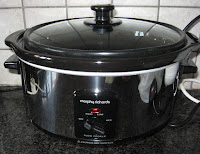I'm basically a 'morning' person. The thought of doing a lot of food preparation in the late afternoon tends to push me towards something as simple as possible. We don’t want omelettes every night... so about five years ago, we decided to buy a slow cooker. These are known in the US as crockpots, but I think of the crockpot as the removable inside part in which the food is cooked, while the slow cooker is the whole appliance, which, basically, cooks food slowly.
BUYING A SLOW COOKER
Our first slow cooker was a large, 6.5 litre Morphy Richards, and I used it extensively; particularly when we had visitors. Unfortunately it developed a crack in the bowl after about three years. It was out of guarantee by then, and I thought it might have been my fault anyway, impatiently putting frozen ingredients in before they were fully thawed. So in the summer of 2010 we decided to buy the smaller, 3.5 litre version which seemed more appropriate since both our sons had left home by then.
The slow cooker comprises a metal outer device containing the cooking mechanism, and a knob on the front which can be set to high, medium, low or off. It should not be switched on unless the inner, ceramic crockpot part is in place, with food inside. The inner part is quite heavy: it’s a smart-looking black oval pot with a pyrex lid which can be carried straight to the table when the food is ready.
COOKING IN THE SLOW COOKER
I bought a couple of useful recipe books which gave me some better suggestions and also some guidelines about using the device. Many recipes suggest gently frying onions, then browning meat, and heating everything else up in a large pan, transferring the lot to the crockpot for 4-6 hours of simmering. I do that sometimes - if making curry, for instance, where it’s important to cook the whole spices at high temperatures initially - but I was pleased to learn that in the majority of cases, it’s fine to place everything in the crockpot uncooked, and give it rather longer.
IMPORTANT PRINCIPLES OF SLOW COOKING
From the instruction guide, my recipe books, and personal experience, the following are the most important general rules I have learned:
- Make sure everything frozen is fully thawed (preferably at room temperature) before adding, so as not to risk cracking the pot
- Place vegetables underneath the meat, as they tend to take longer to cook
- There should be at least some liquid, but it won’t evaporate so needs much less than conventional cooking
- If using dried beans, they do need to be soaked and pre-boiled for at least ten minutes before adding to the slow cooker, as undercooked beans - particularly kidney beans - can be toxic
- If using raw meat, cook for at least an hour on the ‘high’ setting, before leaving it to simmer on low for the rest of the day for the long, slow cooking that brings out the flavour and tenderises even inexpensive cuts of meat
- It’s fine to lift the lid to stir part-way through the cooking, or even to add further ingredients (so long as they are not cold or frozen!) but don’t do this for long as it will lose heat fast
- The lid has a rubber seal which makes a very tight fit; it’s a good idea to release it by lifting before switching the device off, because it can otherwise become almost impossible to remove. [On one notable occasion, we had to remove the screw in the middle of the lid before we could take it off]
- A slow-cooker should not be used for re-heating previously cooked food
CLEANING THE SLOW COOKER
A SLOW COOKER FOR JUST TWO PEOPLE?
Then, after eating two portions of the food, I wait until the rest has cooled down, decant individual portions into small tubs, label, and freeze. If I have six portions of a casserole in all, then that's another two complete meals where I don't even have to do early morning food preparation; I just have to remember to thaw them during the afternoon, then stick them in the oven in a covered pyrex dish to reheat.
RUNNING COSTS
The unit runs at between 150 and 170 watts (depending on setting) - so even if it’s on for ten hours, it only uses about one and a half units of electricity.
CONCLUSION
With delicious meals that apparently cook themselves, low running costs, and the bonus of being able to leave something simmering for hours without any danger of boiling dry, I'm totally converted to slow-cooking. I only wish I'd discovered it years earlier, when my sons were teenagers. Recommended? Absolutely!
2022 UPDATE
This slow cooker has been superseded by more modern variations which are widely available at Amazon and elsewhere. Ours still works, despite now being over ten years old, but I replaced it with a three-pot slow cooker a few years ago, and mostly use that. The Morphy Richards 3.5 litre one is in a cupboard, rarely used any more. But I would still recommend it, or the modern equivalent, for family cooking or for entertaining.

No comments:
Post a Comment